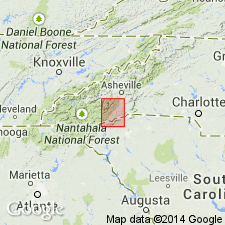
- Usage in publication:
-
- Whiteside granite*
- Modifications:
-
- Original reference
- Dominant lithology:
-
- Granite
- AAPG geologic province:
-
- Piedmont-Blue Ridge province
Summary:
Pg. 4. Whiteside granite. Composed mainly of orthoclase and plagioclase feldspar, quartz, muscovite, and biotite, enumerated in order of importance. Mostly of fine or medium grain. One variety is marked by a decided flow banding. Intrusive into all rocks in which it comes in contact except Triassic diabase. Age is Late Carboniferous(?).
[Named from development in cliffs of Whiteside Mountain, Cowee quadrangle, Jackson Co., western NC. Extends into northwestern SC.]
Source: US geologic names lexicon (USGS Bull. 896, p. 2326).
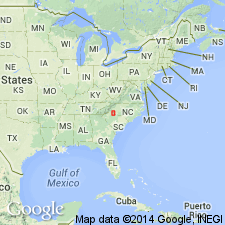
- Usage in publication:
-
- Whiteside granite*
- Modifications:
-
- Areal extent
- AAPG geologic province:
-
- Piedmont-Blue Ridge province
Summary:
Pg. 787. Whiteside granite. Geographically restricted to area of its type locality where it is in part medium-grained biotite-muscovite-quartz-monzonite, having composition that is common in granitic rocks through much of southeast; also includes coarse-grained pegmatitic rock dissimilar to Toluca and Cherryville quartz monzonites (both new). Both Toluca and Cherryville were included in unit assigned to Whiteside granite by Keith and Sterrett (USGS Bull. 660-D, p. 130-132, 1931).
Source: US geologic names lexicon (USGS Bull. 1200, p. 4216).
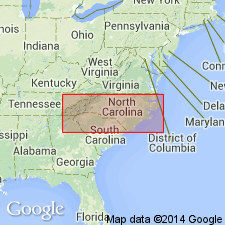
- Usage in publication:
-
- Whiteside granite
- Modifications:
-
- Mapped
- AAPG geologic province:
-
- Piedmont-Blue Ridge province
Summary:
Pg. 24; J.L. Stuckey, 1958, Geol. Map of North Carolina, scale 1:500,000. As mapped, Whiteside granite is essentially the Whiteside granite as originally named and described by Keith (1907). Age is Paleozoic.
[Age is considered Ordovician to Devonian; see Overstreet and Bell (1965).]
Source: US geologic names lexicon (USGS Bull. 1200, p. 4216).

- Usage in publication:
-
- Whiteside Granite*
- Modifications:
-
- Age modified
- Geochronologic dating
- AAPG geologic province:
-
- Piedmont-Blue Ridge province
Summary:
Pg. 89 (geol. time scale), 93 (table 7), 94 (table 8), 108-109. Whiteside Granite. Age changed from late Carboniferous(?) --to-- Ordovician to Devonian on basis of Lead-alpha age determination. (Authors follow revised time scale of Holmes, 1959, Edinburgh Geol. Soc. Trans., v. 17, pt. 3, p. 183-216.)
Source: Publication; Changes in stratigraphic nomenclature, 1964 (USGS Bull. 1224-A, p. A21).
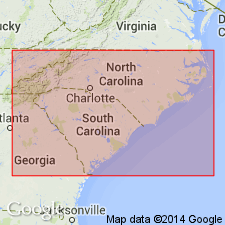
- Usage in publication:
-
- Whiteside Granite*
- Modifications:
-
- Age modified
- AAPG geologic province:
-
- Piedmont-Blue Ridge province
Summary:
Whiteside Granite assigned a Precambrian(?) age in this report based on lead-alpha age of 710 Ma. Monazite ages of 360 to 440 Ma believed to be due to metamorphism (Jaffe and others, 1959).
Source: GNU records (USGS DDS-6; Reston GNULEX).
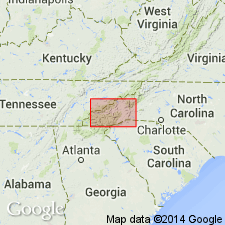
- Usage in publication:
-
- Whiteside Granite*
- Modifications:
-
- Age modified
- AAPG geologic province:
-
- Piedmont-Blue Ridge province
Summary:
Age of Whiteside changed from Precambrian(?) to Devonian(?).
Source: GNU records (USGS DDS-6; Reston GNULEX).
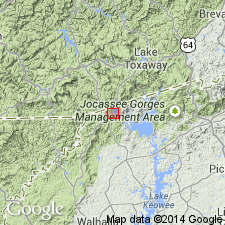
- Usage in publication:
-
- Whiteside Granite
- Modifications:
-
- Areal extent
- AAPG geologic province:
-
- Piedmont-Blue Ridge province
Summary:
Author suggests that unit be restricted to area around Whiteside Mountain or be "completely discarded." Part of unit is here assigned to Toxaway Gneiss, named in this report.
Source: GNU records (USGS DDS-6; Reston GNULEX).
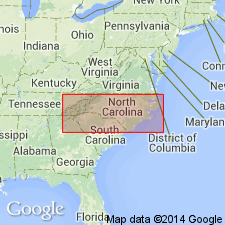
- Usage in publication:
-
- Whiteside Mountain pluton
- Modifications:
-
- Revised
- AAPG geologic province:
-
- Piedmont-Blue Ridge province
Summary:
Unit termed informal Whiteside Mountain pluton and lumped with Stone Mountain, Mount Airy, and Spruce Pine plutons as quartz diorite to granodiorite map unit. Age given as Devonian (390 Ma).
Source: GNU records (USGS DDS-6; Reston GNULEX).
For more information, please contact Nancy Stamm, Geologic Names Committee Secretary.
Asterisk (*) indicates published by U.S. Geological Survey authors.
"No current usage" (†) implies that a name has been abandoned or has fallen into disuse. Former usage and, if known, replacement name given in parentheses ( ).
Slash (/) indicates name conflicts with nomenclatural guidelines (CSN, 1933; ACSN, 1961, 1970; NACSN, 1983, 2005, 2021). May be explained within brackets ([ ]).

